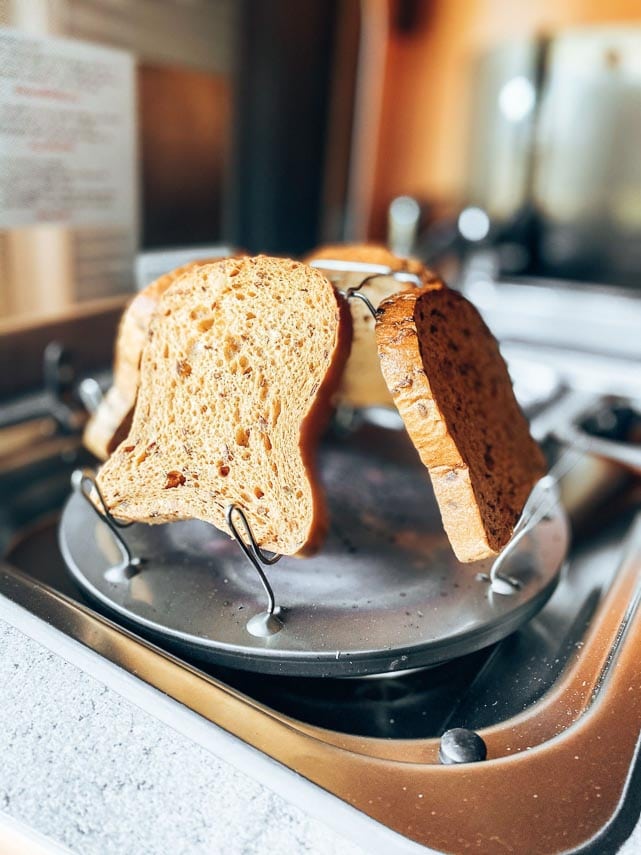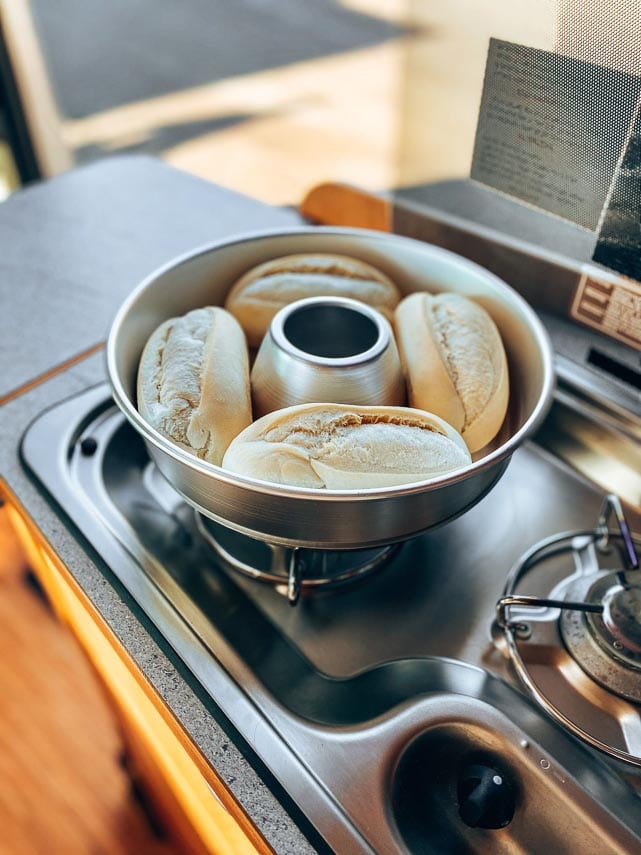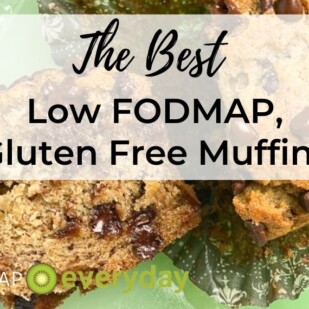One could say, I was born to camp. My family owned a camper van almost all my life and we travelled around in it quite a lot when I was young. Now I’m an adult and living my own life, but camping sure stayed a big part of it.
In this article I will tell you all you need to know about travelling in a camper van with food intolerances and/or IBS: Why is it so amazing? How do you start? What do you bring?

I will share my tips on how to choose your van, which tools and equipment you should bring and even some useful gadgets to consider. Also there are some easy-to-cook recipes for you as well.
But let’s begin at the beginning.
2017: The Camping Adventure Begins
My partner and I bought our first camper van while travelling in Australia in 2017. It was a self-built small labor van conversion and became our home for more than 6 months. We called him “Nobody” because Nobody was perfect for us then.
Now, a few years later, we’re the happy owners of “Nobody 2.0”. This time we chose the “adult” version – a Citroen Jumper base, fully contained and professionally built[1] .

Why You Should Consider Van Travel With IBS
“Home is where you park it” is exactly how van travelling feels. And it is the hominess and comfort that makes this way of travel so absolutely perfect for those of us with food intolerances and/or IBS.
IBS Travel Triggers
Travelling with food intolerances and/or IBS can be stressful at times. For me the worst triggers are:
- Not knowing where or what to eat in a foreign place.
- The fear of not finding a toilet in time or not being able to take the time I need on public toilets.
- Not having a proper night’s sleep
Besides the feeling of pure freedom, I have all the comforts of home with me at all times in my van: I can cook my own food, sleep in my own bed and use my own bathroom whenever I wish.
How To Choose The Perfect Van
There’s probably a million different vans to choose from, so this part can be a bit overwhelming. At the end you just gotta start somewhere though. That’s what we did with our first van in Australia. We looked at a bunch of different ones that were on sale and picked the one that felt best for us at that time.
Our first van was a Kia Pregio – a small labor van that another traveller built into a camper van. It was a so called “low top” with a permanent bed but no sitting area, only a little storage room and no inside kitchen or bathroom.
By the time we sold Nobody, more than half a year later, we knew exactly what we liked and disliked – and started visualizing our next buy. We loved the permanent bed; that one was a keeper. Some other things were improvable, like the possibility of standing up straight, cooking inside the van, sitting area, bathroom…
A few years later, back home in Switzerland, we were really lucky to have found the perfect van for us. “Nobody 2.0” is a Poessl 2 Win Plus – a Citroen Jumper based camper van built that had almost everything on our wish list. We’re now the owners of a fully contained van in which we could easily spend months.

Van Buying Checklist
If you’re thinking about getting a van yourself here are a few options to think about:
- Where would you mainly like to travel? Is a 2WD enough or would you need a 4WD?
- How long will you be on the road? A smaller van is okay for shorter travel, or you might prefer a bigger van with a bit more space, especially for longer trips.
- When’s the perfect travel time for you? Summer or winter makes a big difference in equipment/set up needs.
- How good of a mechanic are you? If you’re like me and don’t know anything about cars, I’d recommend a rather new vehicle.
How To Set Up Your Camping Kitchen
Having your kitchen set up efficiently is a must. Better safe than sorry – that’s my motto when travelling. You never know what’s going to happen, so I like to prepare for all occasions.
That’s why our garage is usually filled up with all kinds of things: from hiking gear to SUPs (stand-up paddle boards). But we also always bring some essentials like emergency kit, fire extinguisher, basic tools, duct tape, headlamp, spare batteries and of course also spare toilet paper, cleaning stuff, etc.
Kitchen Tool Basics
The key to setting up your camper van kitchen is being as minimalistic as possible while still having all you need. For me this means having different pots, pans, forks, knives, plates, bowls, glasses and cups – but all in only exactly the quantity we need. As my partner and I usually travel by ourselves we have everything as a pair: 2 bowls, 2 small plates, 2 large plates, 2 pasta plates, … you get the idea.
Additional Kitchen Essentials
In addition to our basics, we have a few of kitchen tools to recommend.
Folding Camp Stove/Toaster
Ours is probably is one of the the simplest and cheapest ones on the market but we are totally happy with it. Check out this one by Stansport.

It comes in super handy as bread is a crucial thing for me: I love the taste, it’s great for quick meals, but at the same time sometimes is hard to come by (if you need low FODMAP and gluten-free bread). Therefore, I often bring packaged FODMAP gluten-free bread that keeps for a while. The toaster makes it taste fresh and crisp in no time.
Portable Stove Top Oven
Besides the toaster we also have a portable stove top oven, which is great also for heating up bread or for baking some – both are possible with this cool tool. You can also use it for baking cakes, vegetable bakes, cooking “au gratin” or making cheese covered nachos.

As you can see in the picture above, the Omnia probably seems a bit different than your oven at home (it also has a cover, BTW). But don’t be fooled by the looks. Generally it works quite similar. Still, there’s some getting used to and finding the perfect timing. Hopefully I’ll have some recipes to share soon.
Portable Gas Top Stoves, BBQ Grills & Refrigerators
I also highly recommend that you bring a portable gas top stove or a charcoal BBQ grill . That way you can move your cooking outside if you want.
Of course in order to cook properly, you’ll also need something to keep your food chilled. We have a built-in fridge in our van. It even has a tiny freezer, which actually is something I wouldn’t want to do without. It’s great for storing frozen FODMAP-friendly veggies and fruits while on the road.
And just a little side note: when planning or building your own van, make sure to have a window or door by the kitchen that you can open. Most camper vans don’t have a chimney.
Low FODMAP Staple Foods
Cooking in a van (or camp kitchen) is actually quite similar to preparing food at home. The space and resources may be a bit limited, but I usually use the same products and staple foods.
Here are my basic suggestions:
- Rice, quinoa, millet, low FODMAP gluten-free pasta
- Canned tomatoes, chickpeas, coconut milk
- Packaged bread, crisp bread, crackers, crisps
- Nuts and seeds
- Rice syrup and other low FODMAP sweeteners/condiments
- Spices, dried herbs
What Goes In The Camper Van Fridge
We have a good sized refrigerator with a small freezer, so I can even do some meal prep before we begin our trip and bring it along.
Handy things to prep are homemade granola (which keeps even longer in the freezer by the way), sauces/dips, or you could even make full meals you freeze.
Also, I usually bring some low FODMAP veggies, yoghurt, cheese and lactose-free or plant-based milk as well – just whatever I would have had to leave at home when leaving for a trip. The rest I buy locally on the road.
Here’s FODMAP Everday’s Low FODMAP Supermarket Shopping List for you to keep handy.
Buy Local. Eat Well.
This, by the way, is another cool thing about having your kitchen with you wherever you go. When I’m in a foreign country I often buy regional produce and cook according to their cuisine.
This allows me to take in the flavors and experience it all without the hassle of going to a restaurant or the risk of eating something high FODMAP. It’s a much more relaxed and tummy friendly way of experiencing a country’s typical dishes.

One-Pot Dishes For The Win
Creating one-pot or one-dish recipes is something every camper would recommend. Travelling by van means always wisely conserving one’s resources. Preparing everything in one pan or one pot means that you use up less space, and also means less cleaning afterwards. This way you can not only save time and space, but also water.
Another plus when cooking a one-pot-pasta, as example, is that you can use the pasta-water to help create the sauce. Also, when you throw in all the ingredients together, it’s much easier and goes faster.

For some great one-pot ideas you can check these recipes out:
- One-Pot Greek Salmon
- Low FODMAP Thai Curry Tofu & Green Beans
- Low FODMAP Chicken & Lentils
- One-Pan Low FODMAP Pasta & Vegetables
And what I recommend when cooking: make more and keep/freeze the rest for next time. That not only saves you time but resources.
If you have any questions about van life, let me know. I’m happy to give specific recommendations on what to bring, depending on where you go.
Comment here or send me a message on Instagram @theintolerantwanderer
That’s also where you can find more information about my travels on a low FODMAP diet.
♡ Angi

For More Travel Info:
Be sure to check out our main travel hub article: Traveling with IBS: The Comprehensive Guide.







